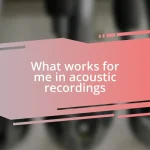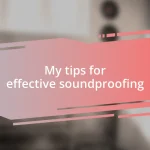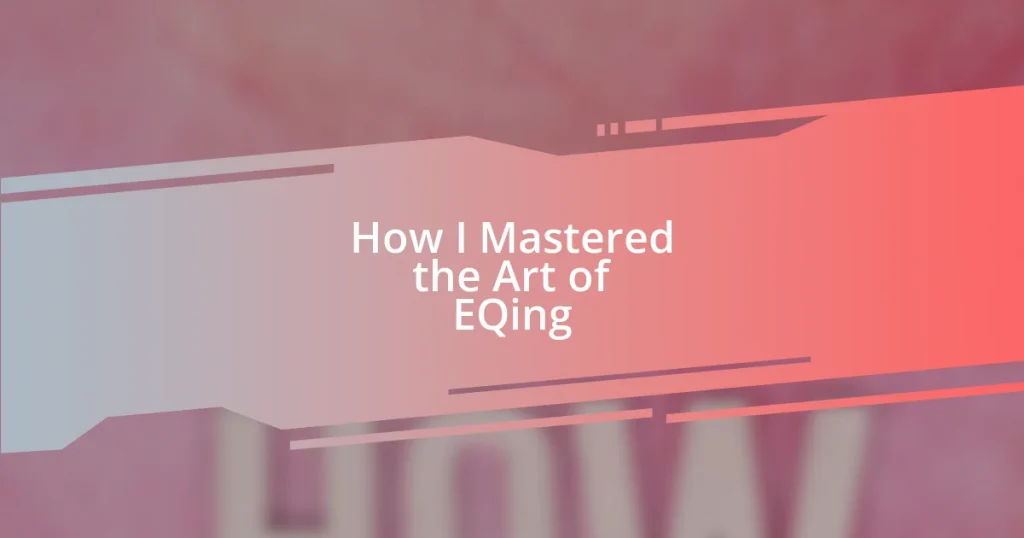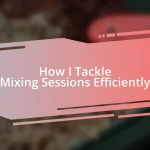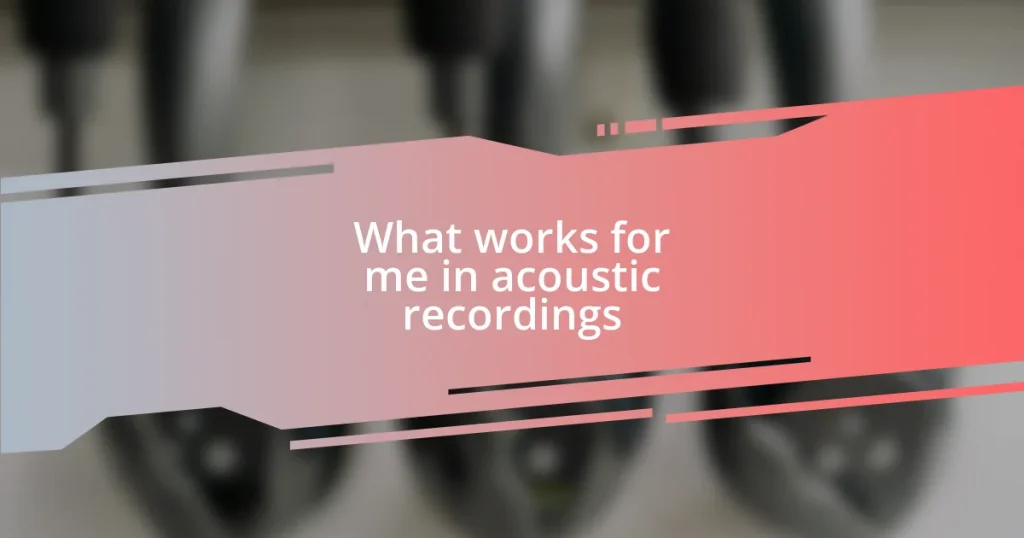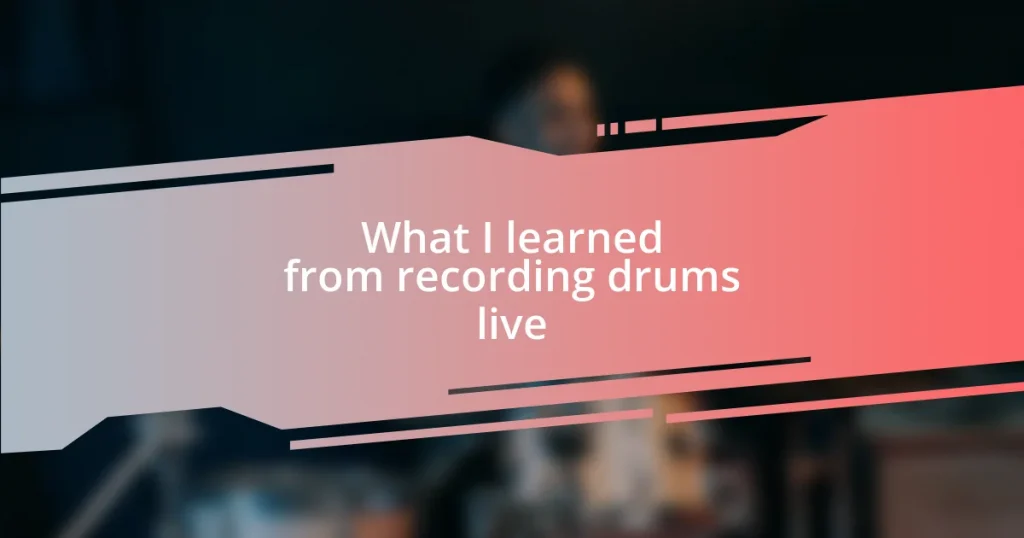Key takeaways:
- Equalization (EQ) techniques allow for shaping a mix’s frequency spectrum, emphasizing specific sounds while cleaning up unwanted frequencies for clarity.
- Understanding frequency ranges is essential; managing sub-bass, bass, midrange, presence, and air can drastically enhance the mix’s impact and balance.
- Advanced techniques like dynamic EQ, mid-side EQ, and parallel EQ can refine mixes, offering more versatility and clarity without overwhelming the overall sound.
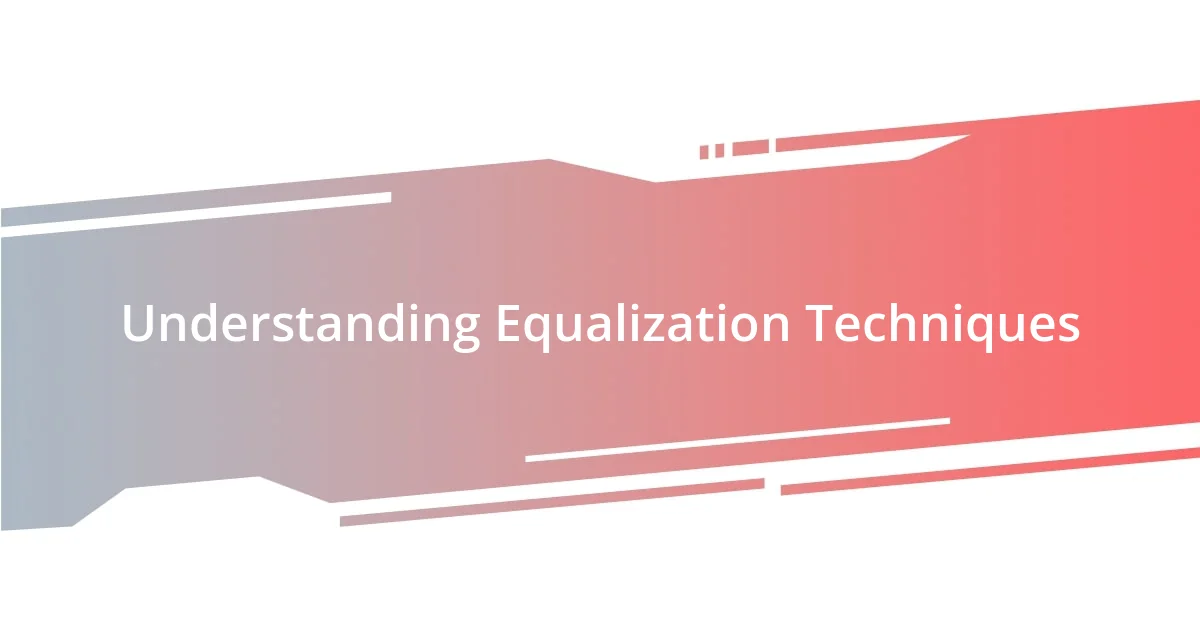
Understanding Equalization Techniques
Equalization (EQ) is like painting a sonic landscape with your music. It allows you to shape the frequency spectrum, emphasizing certain sounds while de-emphasizing others. I remember the first time I was able to bring out the warmth of a vocal track by gently boosting the mid-range; it felt like I was transforming a flat image into a vibrant masterpiece.
When it comes to EQ techniques, there are several approaches, each with its unique flavor. For instance, using a high-pass filter to clean up unwanted low frequencies can make a huge difference. I often find myself asking, have I really listened closely to the low end? I’ll tweak that filter until the muddiness starts to dissipate, and suddenly, clarity prevails, making the entire mix breathe better.
Another staple technique is the use of subtractive EQing. By carefully removing frequencies that clash or muddy the mix, I’ve found that the overall sound becomes sharper and more defined. I once spent hours perfecting a guitar track, cutting out just a few dB at 300 Hz, and the improvement in clarity was astonishing. It’s these small adjustments that bring the music to life, allowing each instrument to shine in its own space. Wouldn’t it be fascinating to think about how the tiniest tweaks can create such vast changes?
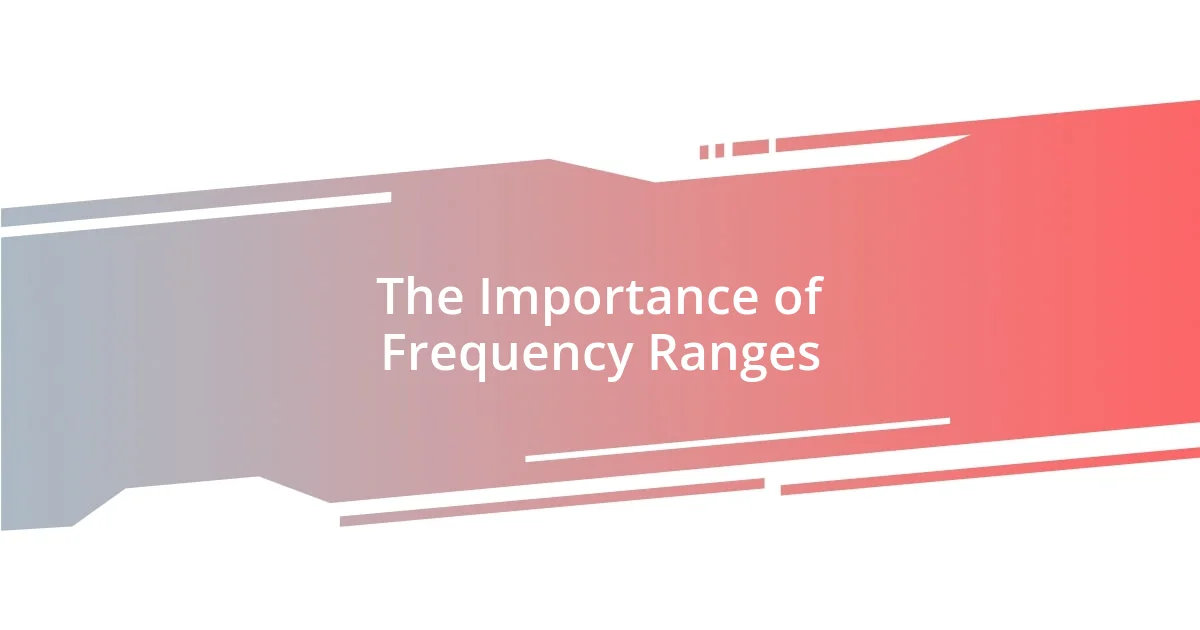
The Importance of Frequency Ranges
When diving into the importance of frequency ranges, I often reflect on how each range holds its unique character. For example, the sub-bass frequencies, typically below 60 Hz, can create a sense of depth and power. I still recall the first time I used a sub-bass boost for a track; it felt like laying a solid foundation that made everything above it resonate. If not carefully managed, however, these low frequencies can easily overwhelm a mix. Striking the right balance is key.
- Sub-Bass (20-60 Hz): Adds warmth and weight, but can create muddiness if overdone.
- Bass (60-250 Hz): Essential for rhythm and groove; requires clarity to support other elements.
- Midrange (250 Hz – 2 kHz): The heart of most instruments and vocals; too much can cause a nasal sound.
- Presence (2-5 kHz): Brings clarity to vocals, often the key to making lyrics pop.
- Air (5 kHz and above): Adds brightness and sheen; overuse can lead to harshness.
Every time I adjust these frequencies, it’s almost like tuning a finely crafted instrument — a delicate balance that I continually strive for to ensure the final output is both enjoyable and impactful.
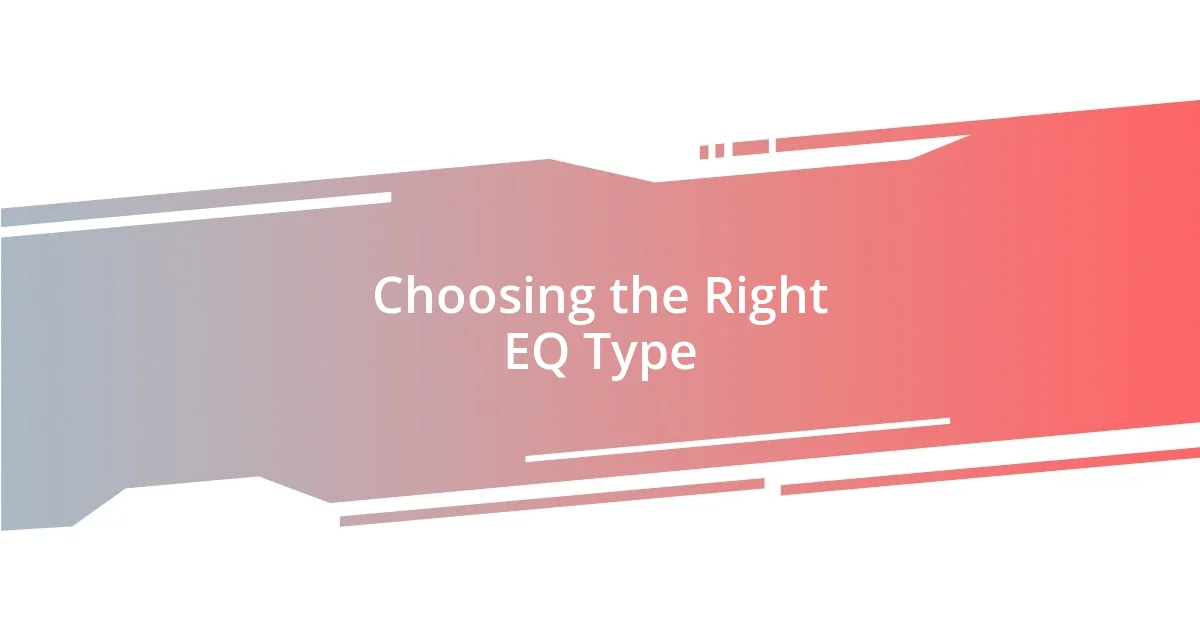
Choosing the Right EQ Type
Choosing the right EQ type can significantly impact your mix, and it often depends on your individual style and the specific elements you’re working with. When I first started, I oscillated between parametric and graphic EQs, trying to understand how each could help achieve my sound goals. Eventually, I found that parametric EQ offered me a level of precision I craved, allowing me to target specific frequencies while adjusting bandwidth more flexibly. I remember the moment I realized that narrowing the Q factor helped my vocals sit perfectly in the mix — it was like finding the right key to unlock a beautiful melody.
On the other hand, graphic EQs have their charm too. They provide a visual representation that’s particularly helpful when I’m troubleshooting mixes in a live context. I can quickly see which frequencies might need a push or a pull. That aha moment came during a live sound check when I noticed a harshness at 3 kHz. By simply lowering that band, the room came alive with richer sound, and the difference was palpable. It’s these distinct functionalities of EQ types that I’ve learned to embrace based on the situation at hand.
I also want to stress that there isn’t a one-size-fits-all approach to choosing an EQ. For instance, during my mixing sessions, I often use dynamic EQs when I need both precision and liveliness in my sound. This method allows me to respond to the audio’s dynamics in real time. I recall mixing a challenging bass track where the notes varied widely. Using dynamic EQ let me tame spikes while still allowing the instrument to breathe and sway, helping to create that exhilarating groove.
| EQ Type | Characteristics |
|---|---|
| Parametric EQ | Offers precision with adjustable bandwidth; great for fine-tuning individual frequencies. |
| Graphic EQ | Visual interface with fixed frequencies; ideal for quick adjustments in live settings. |
| Dynamic EQ | Combines features of parametric EQ and compression; responds to audio dynamics for versatile mixing. |
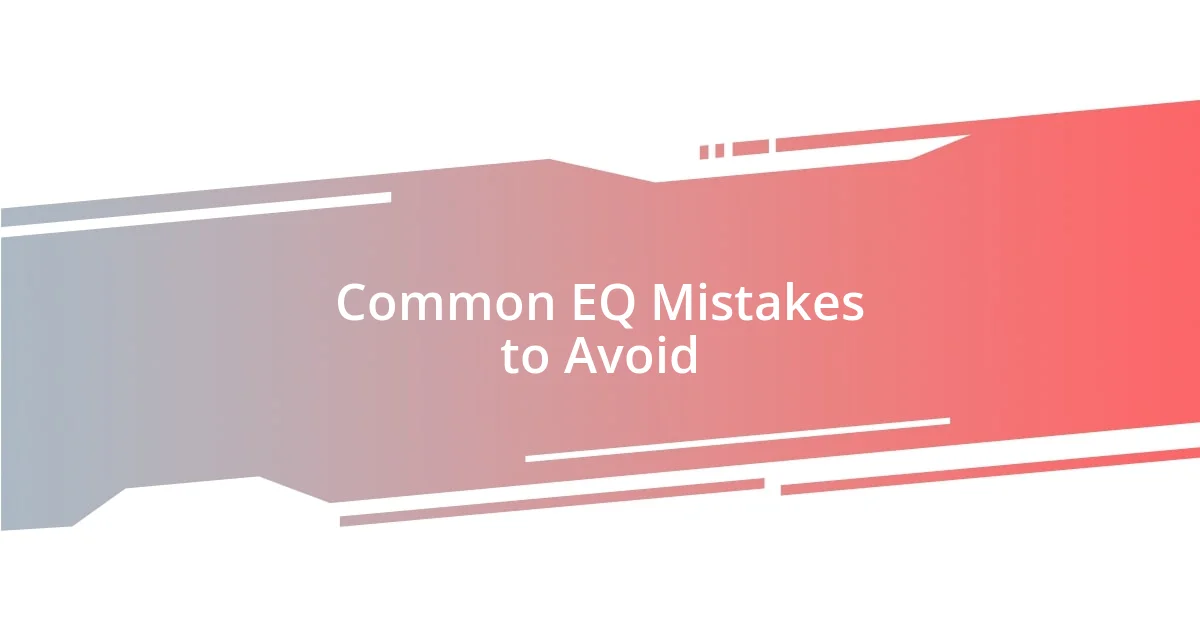
Common EQ Mistakes to Avoid
One common EQ mistake I’ve made is overusing boosts. There’s that temptation to crank up frequencies that just don’t sound right without knowing the real impact it has on the whole mix. I remember a particular track where I was just on a roll, boosting everything I liked. What I learned the hard way is that sometimes less is more. Have you ever found yourself realizing after a long session that all those heavy boosts clashed instead of supporting each other? It can be a tough pill to swallow.
Another pitfall is neglecting the low-end frequencies. Early in my journey, I often pushed midrange content forward, thinking it would create a vibrant sound. But I noticed that the low-end was barely present, leading to a hollow feeling. It hit me when I played it on various systems, and the mix was lifeless. Now, I always ensure that I carve out space for those fundamental lows, as they can be the soul of a track, anchoring everything else. It’s like forgetting the bassline of a song; it leaves you feeling incomplete.
Lastly, relying solely on presets has bitten me more times than I care to admit. Sure, they can save time, but using them without adjustment often results in a generic sound. I recall loading a preset EQ for a vocal track and being excited—until I realized it didn’t match the vibe of my specific song. Each element deserves its unique touch. I’ve learned to treat EQ settings like fingerprints; no two tracks should be the same, and personalizing your approach makes all the difference in creating something truly special.
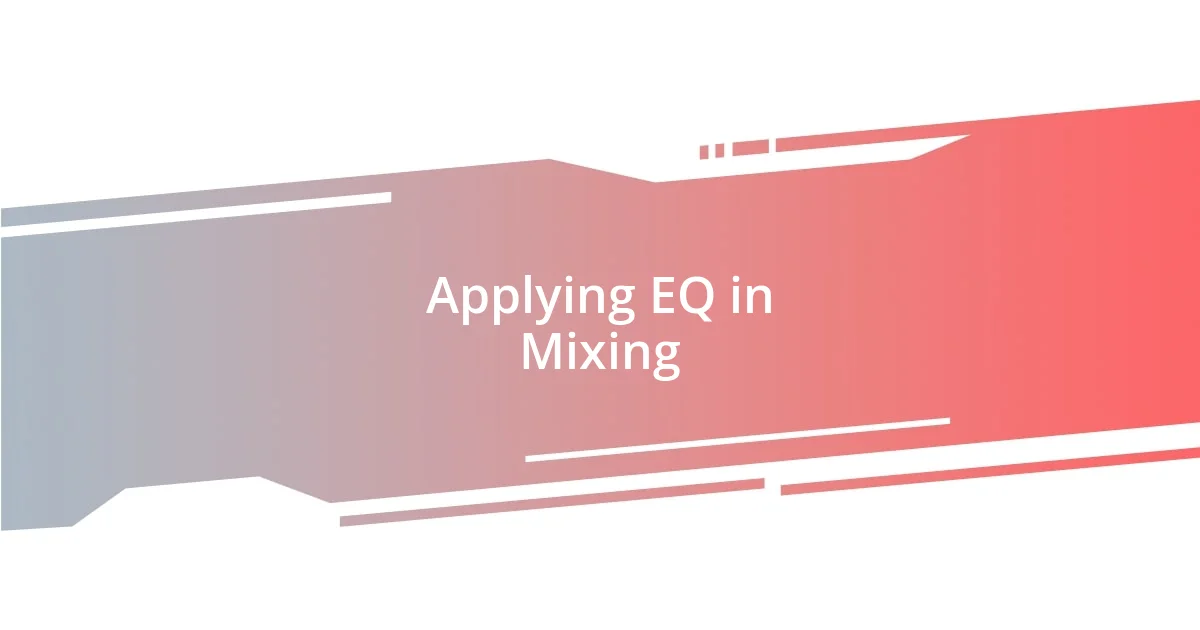
Applying EQ in Mixing
When it comes to applying EQ in mixing, I’ve found that it’s all about the context of each track. For example, I once had a rock guitar track that was coming in too harsh. Instead of just cranking down the high frequencies, I decided to employ a gentle dip around 3 kHz, which really smoothed things out. I felt a rush of satisfaction when I heard that signature grit return without the unpleasant edge — it’s a game-changer to hear how precise adjustments can resurrect a sound.
One technique that truly changed my approach was imagining each track as a seat at a dinner table. Every instrument needs its space to shine, and if they’re fighting for attention, the mix gets chaotic. During a mix for a recent project, I intentionally carved out a niche for the snare in the upper midrange while giving a slight bump to the low end of the kick drum. It’s like finding that perfect arrangement for friends; everyone has room to express themselves, and together, they create a memorable evening.
Additionally, I’ve learned to trust my ears and intuition during the mixing process. I remember a particularly tricky vocal track where I felt compelled to boost the highs to add clarity. After several rounds of tinkering, I realized I was just feeding my ego instead of listening to what the track truly needed. Instead of pushing things too far in the high range, a subtle cut in the mud area made the vocals pop beautifully. It’s moments like this that remind me: mixing is a blend of artistry and technical skill, where each adjustment can evoke a powerful emotional response.
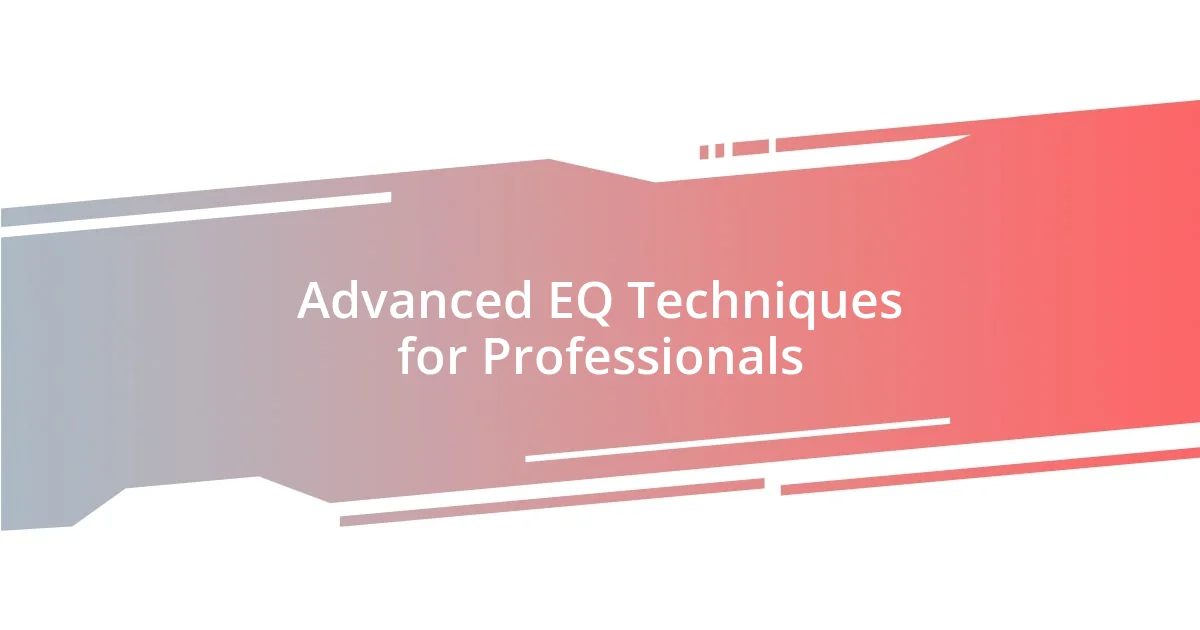
Advanced EQ Techniques for Professionals
One advanced EQ technique I’ve found incredibly effective is using dynamic EQ. I remember tackling a particularly challenging mix where certain frequencies would only misbehave during specific parts of a song. I adjusted the dynamic EQ settings to gently compress those frequencies only when they became overly prominent. It was like having a smart assistant who knew exactly when to step in and hold back just enough to let the mix breathe. Have you ever experienced those pesky peaks that pop up out of nowhere? This approach not only addressed the problem but also preserved the natural flow of the track.
Another powerful technique is the use of mid-side EQ. In one project, I had a lush stereo piano arrangement that was competing with the vocal. Instead of resorting to drastic measures, I split the signal and applied EQ differently to the mid and side channels. Boosting the width in the sides while cutting a bit of the lower mids in the center helped the piano stand out without overshadowing the vocals. Have you ever played with stereo imaging that brought your mix to life? This subtle manipulation can create depth and clarity in ways that traditional EQ can’t match.
Finally, I’ve embraced parallel EQ as a method to enhance specific elements without overwhelming the mix. I recall a time when a bass line was sounding great but felt a little too safe. By duplicating the track and applying aggressive EQ boosts to the duplicate—like a hefty boost at 60 Hz—I was able to create a more exciting presence. Blending it back with the original track allowed me to retain the foundation while adding a punch I didn’t know was missing. Isn’t it amazing how a little creativity can unlock the potential of a mix? This balance of layering has often led to some of my most satisfying results.
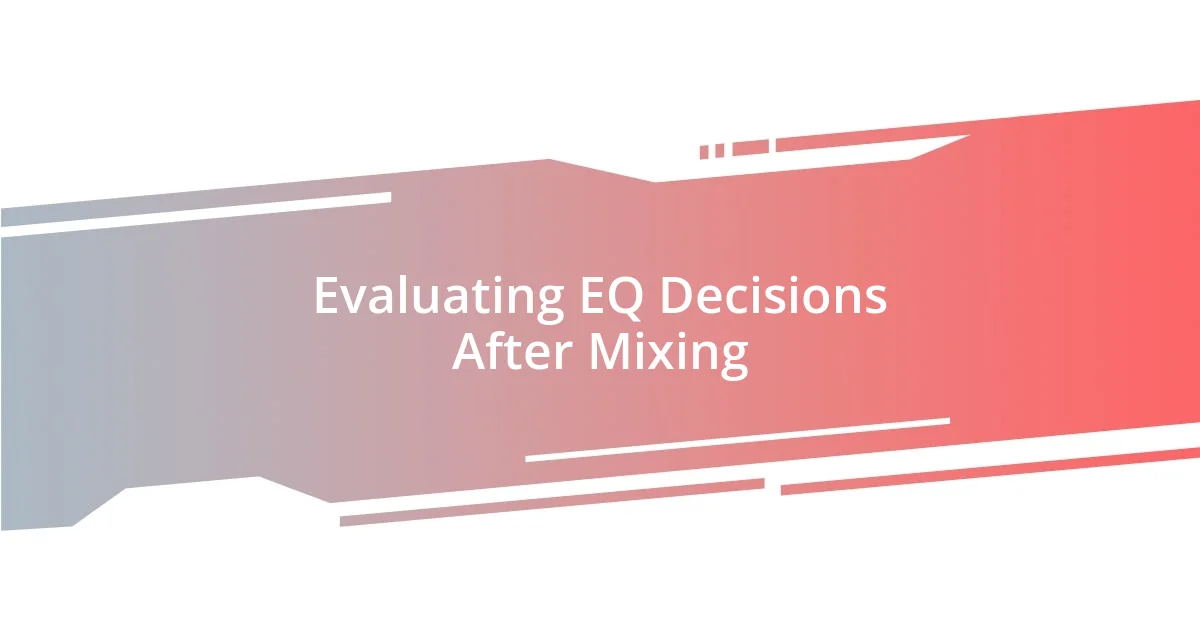
Evaluating EQ Decisions After Mixing
Evaluating EQ decisions after mixing is crucial for achieving a polished sound. I vividly recall a mix that seemed perfectly balanced at first, but when I revisited the track the next day, I noticed something off. It felt like a clunky puzzle piece that just wouldn’t fit, so I decided to reassess my EQ settings. By listening with fresh ears, I understood that a bit more clarity in the midrange could lift the overall energy of the song. Have you ever experienced that revelation after stepping away from a project? It’s enlightening.
Listening back to a mix can often reveal whether the EQ choices truly serve the music. I had a vocal track that felt buried under instruments. Initially, I was tempted to boost its presence with aggressive highs, but after some reflection, I realized a gentle dip in the competing frequencies allowed the vocals to rise naturally. This taught me that sometimes restraint in EQ is more powerful than excess. Do you ever find that less can be more in mixing?
I also learned to trust my instinct during the evaluation phase. There was a moment when I felt compelled to make big adjustments after the mix, but instead, a small tweak in the low end did wonders. The satisfaction of hitting play and hearing the mix snap into focus can’t be underestimated. It’s almost like the track breathes a sigh of relief! This process isn’t just technical; it’s about forming a connection with each element to create something harmonious.

